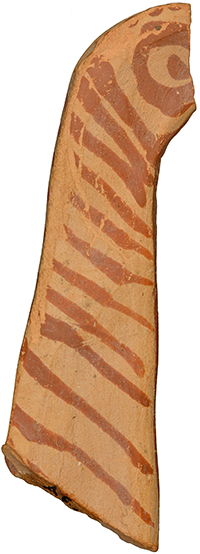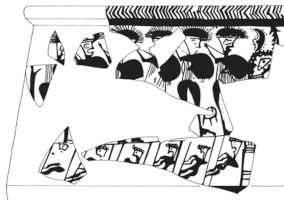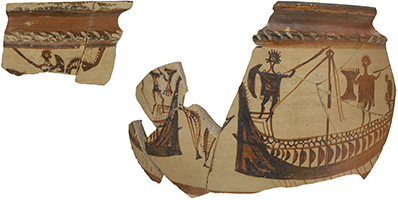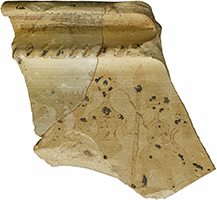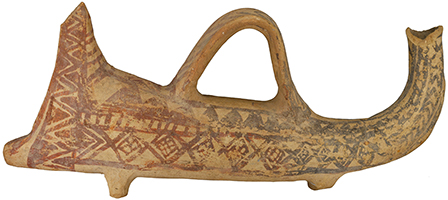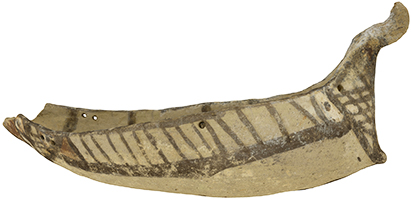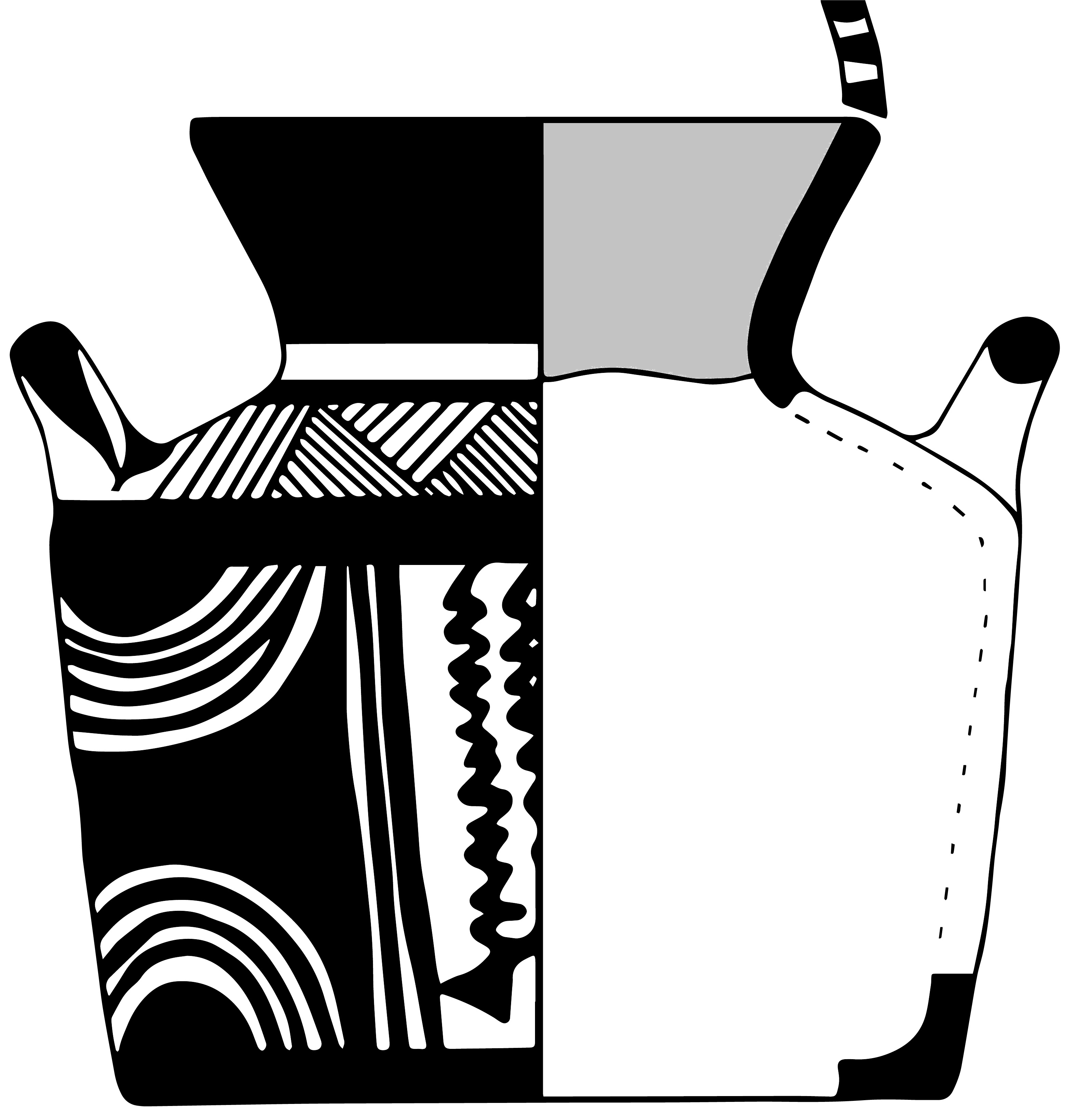The hull is rendered by a continuous thick flat line that tapers to a pointed spur to the right, and thins out to a curved high sternpost surmounted by a club-like/ acorn-shaped device to the left. Twenty four stanchions placed at fixed intervals forming 25 rooms (rowers' stations) are represented by short vertical lines joining the gunwale to the keel, indicating this is a penteconter. The bow consists of a vertical stem drawn with two lines joined by a zig-zag pattern, surmounted by a bird-headed stempost with recurving beak and parallel short lines extending from its inboard surface. There is a forecastle behind the bow, on top of which is a perched water bird with a recurving beak. A line projecting midway up the stem resembles the bow projection in the same position on the first Kynos ship. It differs however in that it does not continue the line of the possible wale as on the Kynos ship, and might represent a primitive form of subsidiary spur (proembolon)(Wachsmann 1998: 137). At the stern there is an aftercastle with a single large quarter rudder, the tiller held in place by a linchpin connected to the loom. Both castles have open balustrades similar to the Kynos ship. The mast cap is equipped with two sheaves, indicating the newly introduced brailed sail. The sail is billowing to the right, forward of the mast. There is a single forestay joining the mast to the forecastle, a backstay and two halyards leading from the top of the mast to the sterncastle (similar to Phylakopi depiction). A fourth line seemingly attached to the mast found halfway astern possibly represents a brace or bunched brails.
Helladic galley
A111
LH IIIC late (end of 12th-early 11th B.C.)
Tragana, tholos tomb 1
H: 15.2 cm; diam. lip: 9.5-10.5 cm; diam. neck: 8 cm; diam. shoulder: 13-14.6 cm
Straight sided alabastron. Pale brown slip and brown paint (very faded)
Athens National Archaeological Museum 6098
Basch 1987: 141-42, nos. 297, 298; Delivorrias 1987: 156, no. 56 (outdated drawing); Eder 2006: 550-52; Evans 1928: 246-247, fig. 143; Guglielmino 1979: 439-440, no. 14, tav. XLIII.1; Kirk 1949: 118 (iv); Korrés 1977: 238-240; 1983: 206-208; 1989; Kourouniotis 1914: 107-109; Marinatos 1933: 173, no. 17; Mountjoy 1999: 358, fig. 123, Messenia no. 132; Sakellarakis 1992: 115-16, no. 255; Tartaron 2013: 51, fig. 3.3; Tzahou-Alexandri and Spathari 1987: 79, no. 40; Vlachopoulos 2018: 563-564, fig. 13; Wachsmann 1981: 202-204; 1998: 137, fig. 7.17; Wedde 2000: 324, no. 643; Tomb: Guglielmino 1979; Marinatos 1955; Skias 1909: 274-292
The village of Tragana is located near the eastern end of one of the main ridges that slope down to the sea from the foothills of Mt. Aigaleon. The two tholos tombs were discovered and excavated by Kourouniotis on top of a hill near the modern village. Tragana tholos tomb 1 (like its sisters) was in use during LH IIIA, after which there is a hiatus in LH IIIB. It was then re-used in LH IIIC, with a series of continuous burials covering a period from the 12th to the 9th century (possibly even longer). Besides the alabastron bearing the ship depiction, the tholos has provided a variety of LH IIIC shapes, including a krater, amphora, pyxis, kylix, oenochoe, phiale, and five lekythoi.
Eder has noted the significance of the findspot of this ship representation, since the tholos tomb was located just above an artificially created harbour basin (Eder 2006: 550-551) which was identified through geological investigations carried out by the Pylos Regional Archaeological Project (Zangger et al 1997: 613-23). The builders used a natural depression made of soft fossil dunes located about 500 m from the Bronze Age shoreline which they widened and deepened in order to serve as the harbour basin, which in turn was connected to a small natural cove which probably served as the original anchorage by digging a 40-50 m wide channel. In order to prevent the basin's silting up, the perennial Selas river was diverted into a lake, from where an artificial canal leading to the harbour basin provided a steady outflow of clean water to flush out the harbour. The diversion of this river has been dated to the LBA based on a sharp drop in terrestrial sediments from the Osmanaga Lagoon which was the natural outlet of the river prior to its diversion. The result of this sophisticated hydraulic engineering project was a well-sheltered and highly defensible inner harbour.
The ship depiction is unusually long, occupying close to two thirds of the surface of the alabastron’s body. The stempost of the ship is centered between the handles, but the ship is so long than it continues in the back of the vase. Perched atop the ship’s forecastle is a bird, previously wrongly reconstructed as a fish (Delivorrias 1987: 156, no. 56). It is fragmentary and what remains is quite faded, showing the rear-part with the tail, the wings which are rendered by two curved lines, and two feet. The edge of the break possibly also preserves part of the long neck. The forepart and head are not preserved. Bird depictions of this period are quite variable. According to Binnberg, the bird depicted on the alabastron however shows some characteristics which are found on waterbirds on vases from Attica and the islands, in contrast to those of the Argolid which have a different appearance. The closest morphological parallel for the bird comes from a stirrup jar from Naxos (Naxos Archaeological Museum 2085; Meiberg 2011: 453-454, no. 485) Characteristics such as the wings rendered by wavy lines, the elongated body, and the ‘fish-like’ tail are found on vases and larnakes from Crete, as well as on some octopus stirrup jars from Kalymnos, Naxos, and Perati (Julia Binnberg 2023, personal communication). The connection to Perati is also reinforced by the close parallel between the Tragana ship’s figurehead and a pair of protomes depicted on a LH IIIC middle stirrup jar from Perati tomb 10 (Binnberg 2018: G572).
The ship depicted is a penteconter. The ability to remove the tiller from the loom would have been advantageous when the mechanism was stored.
Basch, L. 1987. Le musée imaginaire de la marine antique. Athens: Institut Hellénique pour la preservation de la tradition nautique.
Binnberg. J. 2018. "Birds in the Aegean Bronze Age." Unpublished PhD thesis, University of Oxford, UK.
Delivorrias, A. (ed.) 1987. Greece and the Sea. Catalogue of the exhibition organized by: the Greek Ministry of Culture, the Benaki Museum, the National Foundation De Nieuwe Kerk, Amsterdam, in honour of Amsterdam Cultural Capital of Europe 1987. Athens.
Evans, A. J. 1928. The Palace of Minos. Vol II. London: Macmillan.
Guglielmino, R. 1979. “La “tholos” Nr. 1 di Tragana,” Annali della Acuola Superiore di Pisa. Classe di Lettere e Filosofia. 9.2: 425-457.
Kirk, G.S. 1949. “Ships on Geometric Vases.” BSA 44: 93-153, pls. 38-40.
Korrés, G.S. 1977. “Εργασίαι, έρευναι και ανασκαφαί ανά τὴν Πυλίαν,” PAE, A : 229-295.
―――. 1983. “Ανασκαφή Βοϊδοκοιλιάς Πυλίας,” PAE : 169-208.
―――. 1989. “Νέαι παρατηρήσεις ἐπί τῆς παραστάσεως πλοίου τῆς ΥΕ ΙΙΙΓ:1 πυξίδος ἐκ Τραγάνας Πύλου,” in H. Tzalas (ed.) TROPIS I: 1st International Symposium on Ship Construction in Antiquity. Piraeus, 30 August – 1 September 1985. Piraeus: Hellenic Institute for the Preservation of Nautical Tradition, pp. 177-202.
Kourouniotis, K. 1914. “Πύλου Μεσσινιακης θολωτός τάφος,” AE: 99-117.
Marinatos, S. 1933. “La marine créto-mycénienne,” BCH 57: 170-235.
―――. 1955. “Ανασκαφαί εν Πύλω,” Πρακτικὰ τῆς ἐν Ἀθήναις Ἀρχαιολογικῆς Ἑταιρείας: 245-255.
Mountjoy, P.A. 1999. Regional Mycenaean Decorated Pottery. Rahden: Deutsches Archäologisches Institut.
Sakellarakis, J.A. 1992. Mycenaean Pictorial Style in the National Archaeological Museum of Athens. Athens: Kapon Editions.
Skias, A.N. 1909. “Ανασκαφικη Εν πυλου της Μεσσηνίας,” Praktika tes en Athinais Archaiologikes Hetaireias: 274-292.
Tartaron, T. F. 2013. Maritime Networks in the Mycenaean World. Cambridge: Cambridge University Press.
Tzahou-Alexandri, O. and Spathari, E. 1987. A Voyage into Time and Legend aboard the Kyrenia Ship. Athens: Ministry of Culture.
Vlachopoulos, A.G. 2018. From “Koine” to “Void”? The Art of Paintbrushes in Postpalatial Greece and their Social Implications,” In In A.G. Vlachopoulos (ed.) Paintbrushes. Wall-Painting and Case-Painting of the Second Millennium BC in Dialogue. Athens: Hellenic Ministry of Culture and Sports, pp. 557-567.
Wachsmann, S. 1981. “The Ships of the Sea People,” IJNA 10: 187-220.
―――. 1998. Seagoing Ships & Seamanship in the Bronze Age Levant. College Station, TX: Texas A&M University Press.
Wedde, M. 2000. Towards a Hermeneutics of Aegean Bronze Age Ship Imagery. Peleus Studien zur Archäologie und Geschichte Griechenlands und Zyperns, vol. 6. Bibliopolis: Mannheim and Möhnsee.



